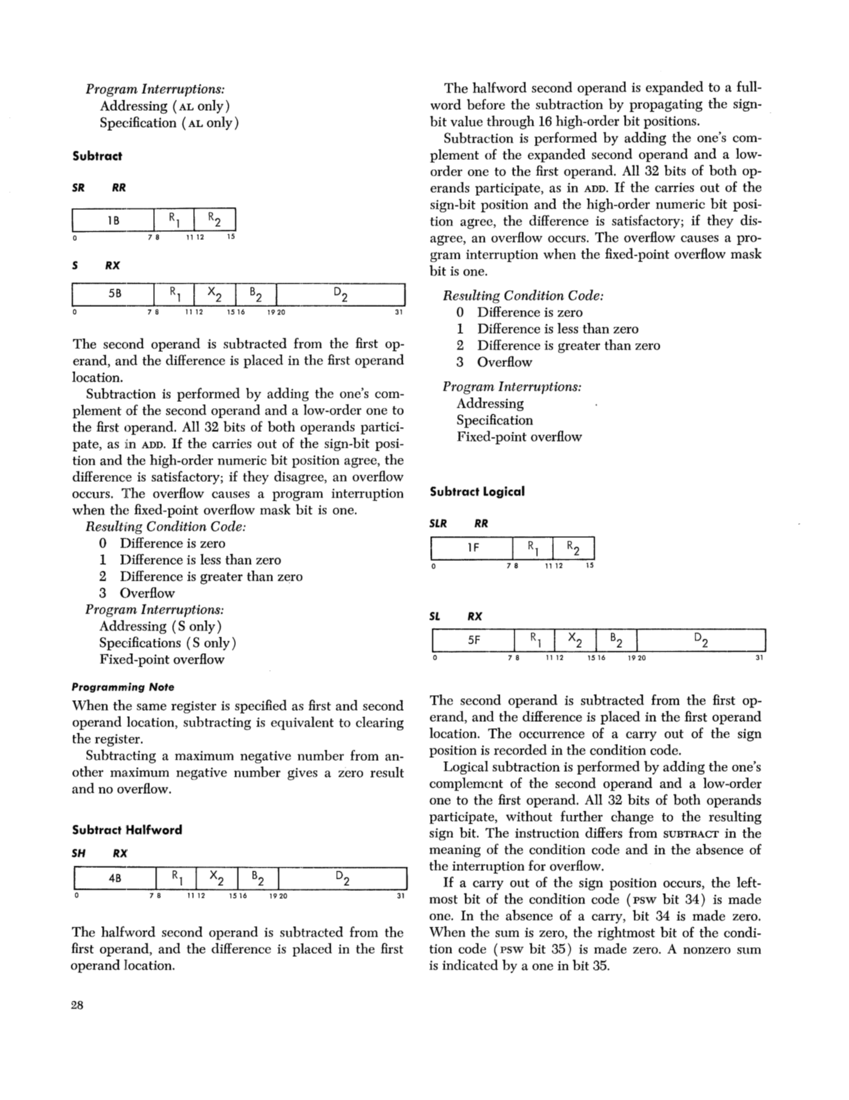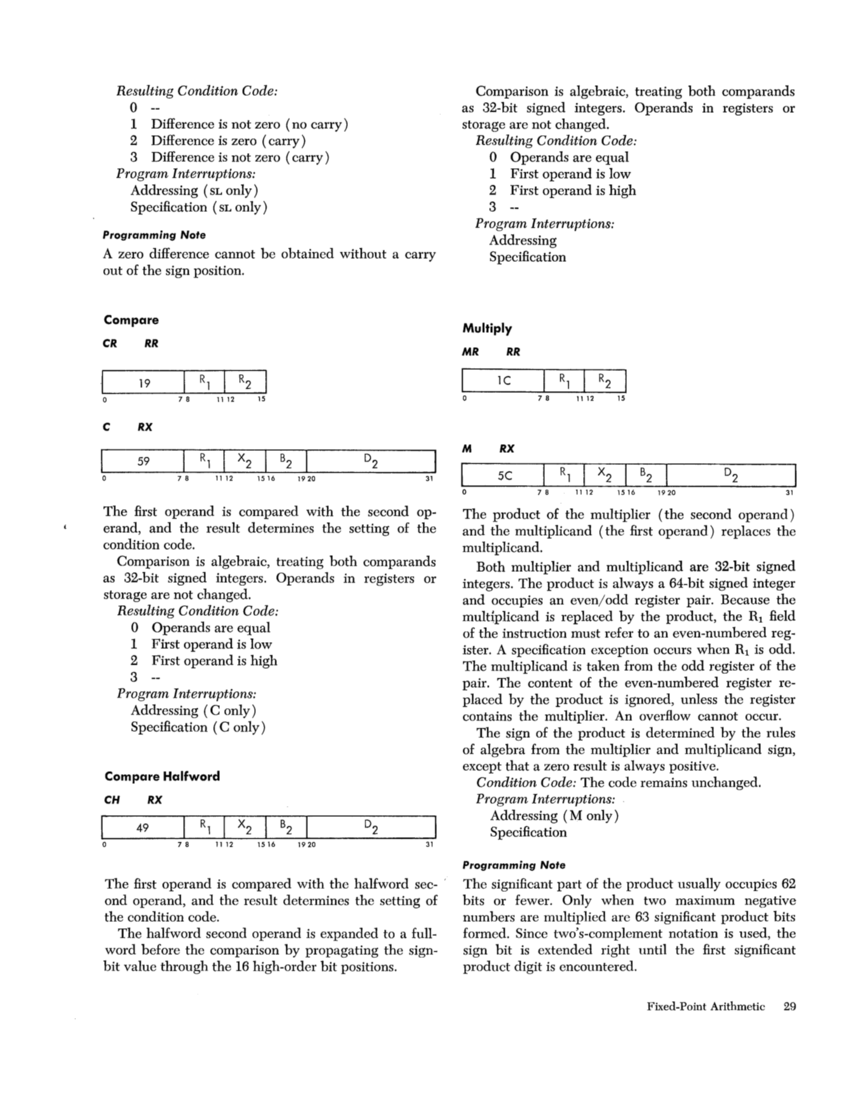Program Interruptions:
Addressing (AL only)
Specification (AL only)
SubtractSR RR I 1B I R1 R2 0 78 11 12 15 S RX I 5B I R1
X
2
B2 D20 7 8 11 12 1516 1920 31
The second operand is subtracted from the first op
erand, and the difference is placed in the first operand
location.
Subtraction is performed by adding the one's com
plement.of the second operand and a low-order one to
the first operand. All 32 bits of both operands partici
pate, asin ADD. If the carries out of the sign-bit posi
tion and the high-order numeric bit position agree, the
difference is satisfactory; if they disagree, an overflow
occurs. The overflow causes a program interruption
when the fixed-point overflow mask bit is one.ResulUng Condition Code:
o Difference is zero
1 Difference is less than zero
2 Difference is greater than zero
3 OverflowProgram Interruptions:
Addressing(S only)
Specifications(S only)
Fixed-point overflow
Programming Note
When the same register is specified as first and second
operand location, subtracting is equivalent to clearing
the register.
Subtracting a maximum negative number from an
other maximum negative number gives a zero result
and no overflow.
Subtract:Halfword SH RX 4B
7 8 11 12 15 16 1 920 31
The halfword second operand is subtracted from the
first operand, and the difference is placed in the first
operand location.
28
The halfword second operand is expanded to a full
word before the subtraction by propagating the sign
bit value through 16 high-order bit positions.
Subtraction is performed by adding the one's com
plement of the expanded second operand and a low
order one to the first operand. All 32 bits of both op
erands participate, as in ADD. If the carries out of the
sign-bit position and the high-order numeric bit posi
tion agree, the difference is satisfactory; if they dis
agree, an overflow occurs. The overflow causes a pro
gram interruption when the fixed-point overflow mask
bit is one.
Resulting Condition Code:
o Difference is zero
1 Difference is less than zero
2 Difference is greater than zero
3Overflow Program Interruptions:
AddressingS pecifica tion
Fixed-point overflow
SubtractLogical SLR RR
1 F
78 1112 15SL RX
5F
7 8 11 1 2 15 16 1 920 31
The second operand is subtracted from the first op
erand, and the difference is placed in the first operand
location. The occurrence of a carry out of the sign
position is recorded in the condition code.
Logical subtraction is performed by adding the one's
complement of the second operand and a low-order
one to the first operand. All 32 bits of both operands
participate, without further change to the resulting
sign bit. The instruction differs fromSUBTRACT in the
meaning of the condition code and in the absence of
the interruption for overflow.
If a carry out of the sign position occurs, the left
most bit of the condition code (psw bit 34) is made
one. In the absence of a carry, bit 34 is made zero.
When the sum is zero, the rightmost bit of the condi
tion code (psw bit 35) is made zero. A nonzero sum
is indicated by a one in bit 35.
Addressing (AL only)
Specification (AL only)
Subtract
X
2
B2 D2
The second operand is subtracted from the first op
erand, and the difference is placed in the first operand
location.
Subtraction is performed by adding the one's com
plement
the first operand. All 32 bits of both operands partici
pate, as
tion and the high-order numeric bit position agree, the
difference is satisfactory; if they disagree, an overflow
occurs. The overflow causes a program interruption
when the fixed-point overflow mask bit is one.
o Difference is zero
1 Difference is less than zero
2 Difference is greater than zero
3 Overflow
Addressing
Specifications
Fixed-point overflow
Programming Note
When the same register is specified as first and second
operand location, subtracting is equivalent to clearing
the register.
Subtracting a maximum negative number from an
other maximum negative number gives a zero result
and no overflow.
Subtract
7 8 11 12 15 16 1 9
The halfword second operand is subtracted from the
first operand, and the difference is placed in the first
operand location.
28
The halfword second operand is expanded to a full
word before the subtraction by propagating the sign
bit value through 16 high-order bit positions.
Subtraction is performed by adding the one's com
plement of the expanded second operand and a low
order one to the first operand. All 32 bits of both op
erands participate, as in ADD. If the carries out of the
sign-bit position and the high-order numeric bit posi
tion agree, the difference is satisfactory; if they dis
agree, an overflow occurs. The overflow causes a pro
gram interruption when the fixed-point overflow mask
bit is one.
Resulting Condition Code:
o Difference is zero
1 Difference is less than zero
2 Difference is greater than zero
3
Addressing
Fixed-point overflow
Subtract
1 F
78 1112 15
5F
7 8 11 1 2 15 16 1 9
The second operand is subtracted from the first op
erand, and the difference is placed in the first operand
location. The occurrence of a carry out of the sign
position is recorded in the condition code.
Logical subtraction is performed by adding the one's
complement of the second operand and a low-order
one to the first operand. All 32 bits of both operands
participate, without further change to the resulting
sign bit. The instruction differs from
meaning of the condition code and in the absence of
the interruption for overflow.
If a carry out of the sign position occurs, the left
most bit of the condition code (psw bit 34) is made
one. In the absence of a carry, bit 34 is made zero.
When the sum is zero, the rightmost bit of the condi
tion code (psw bit 35) is made zero. A nonzero sum
is indicated by a one in bit 35.









































































































































































